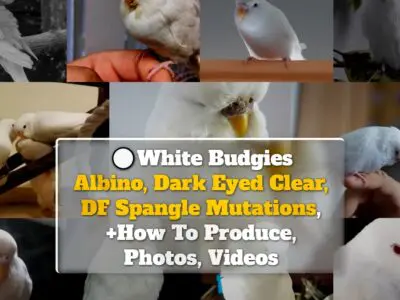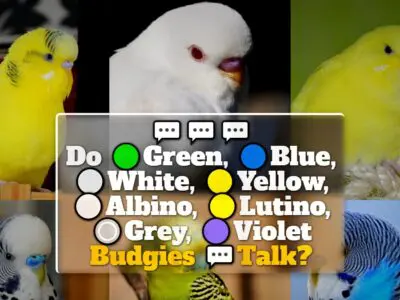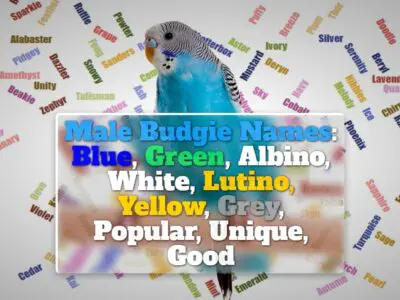An all-yellow or all-white budgie may have a genetic mutation, such as the Ino gene mutation, leading to Albino (white) or Lutino (yellow) budgies.
Alternatively, your budgie might be a Dark-Eyed Clear or a Df Spangle, both of which can result in solid coloration.
As a pet owner, it’s natural to want to understand your little buddy better, and understanding why their feathers take on certain colors can lead to a deeper appreciation for these remarkable creatures.
Whether your budgie is all yellow or all white, the cause is usually down to genetics, specifically certain mutations.
Let’s explore this in more detail.
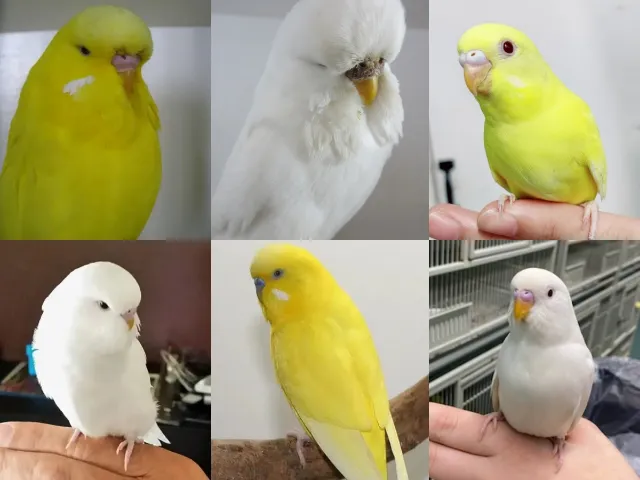
Why Is My Budgie All Yellow?
When you look at your budgie and wonder, “Why is my budgie all yellow?”, you’re actually asking a question deeply rooted in genetics.
To understand the answer, we need to explore two primary factors: the Ino gene mutation and other feather color variations.
Ino Gene Mutation (🟡 Lutino Albinism)
The first possibility to consider is that your all-yellow budgie could be a Lutino.
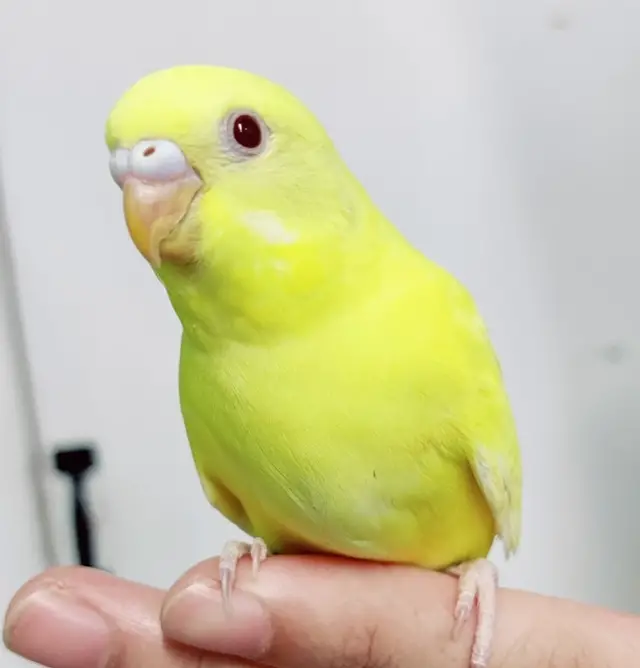
Lutino budgies are a type of albino budgie.
Although albinism is generally associated with all-white creatures with pink or red eyes, in budgies, there’s an intriguing twist.
The albinism we see in budgies results from a mutation in a gene called the Ino gene.
The Ino gene is a little piece of genetic code that has a big job – it’s responsible for managing the production of a pigment called melanin.
Melanin is what gives color to a budgie’s feathers, eyes, beak, and feet.
When the Ino gene is functioning normally, it enables the budgie to produce normal levels of melanin, leading to a wide range of possible colorations.
However, when there’s a mutation in the Ino gene, things change.
An Ino gene mutation results in a decrease in melanin production.
This leads to a lighter coloration in the budgie, often resulting in the albino phenotype – all white with red or pink eyes.
But remember, we’re trying to explain why a budgie is all yellow, not all white.
Here’s where it gets interesting.
Despite the decrease in melanin, other pigments in the budgie’s feathers may still be produced.
This means the yellow pigment, unaffected by the Ino gene mutation, still gets expressed, leading to a budgie that is all yellow – a Lutino.
It’s fascinating, isn’t it?
What makes this even more intriguing is the genetic aspect.
This Ino gene mutation is sex-linked and recessive, which means a female budgie needs to inherit this mutation from both parents to display the Lutino phenotype.
Males, on the other hand, can carry the mutation without showing the yellow coloration and can pass it onto their offspring.
This could be one reason why your budgie is all yellow.
But what if your budgie isn’t a Lutino? Well, there are other possibilities, and they also lie in the realm of genetics and feather color variations.
Dark-Eyed Clear Budgie
Another explanation for an all-yellow budgie could be that it’s a Dark-Eyed Clear Budgie.
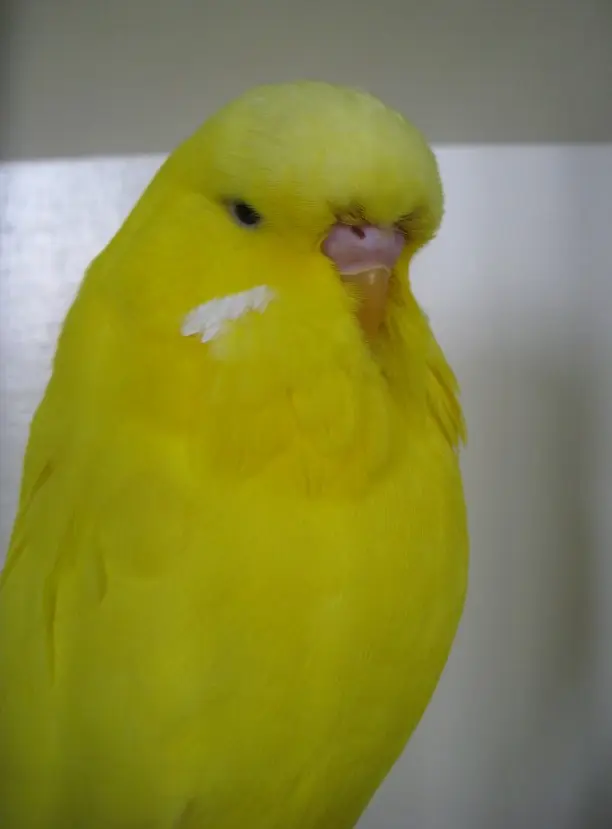
This particular variety of budgie is quite fascinating and contributes to the rich diversity of budgie mutations.
The Dark-Eyed Clear (often abbreviated as DEC) is a budgie variety where the bird displays uniformly yellow (or white) feathers with dark, rather than red or pink, eyes.
The name itself is a literal description of the bird – ‘clear’ referring to the absence of any markings or differentiating colors on the body, and ‘dark-eyed’ denoting the color of the eyes.
How does this happen, you might wonder? Well, it comes down to another interesting dance of genes.
Dark-Eyed Clears result from a combination of two specific genetic traits: the Clearflight Pied trait and the Recessive Pied trait.
In the wonderful world of budgie genetics, pied refers to having patches of white or yellow feathers, breaking up the base color of the bird.
The Clearflight Pied trait typically results in a budgie with clear (unmarked) flights (long feathers on the wings) and often a clear tail.
On the other hand, the Recessive Pied trait results in a budgie with patches of yellow or white throughout the body, interrupting the base color.
When both these traits come together in a single budgie, the result is a Dark-Eyed Clear Budgie – a budgie with uniformly yellow feathers and dark eyes.
The Pied traits effectively ‘override’ the base color, resulting in an all-yellow (or all-white) appearance.
So, if your budgie has uniformly yellow feathers, without any patches or markings of different color, and its eyes are dark, you likely have a Dark-Eyed Clear budgie.
Isn’t the world of budgie genetics intriguing?
This is the second reason why your budgie could be all yellow.
But there’s one more possibility we should explore, and that involves a variety known as the Df Spangle Budgie.
Let’s take a look at that next.
Df Spangle Budgie
The third reason why your budgie could be all yellow is that it might be a Df Spangle Budgie.
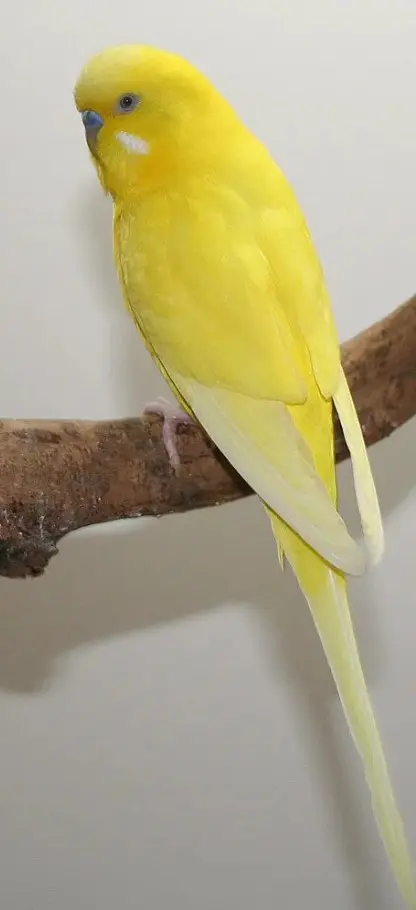
The term “Df” stands for double factor, referring to a specific trait a budgie has inherited from both its parents.
A Df Spangle Budgie carries two copies of the spangle gene, one from each parent.
The Spangle mutation is another fascinating example of genetic variation in budgies.
Spangle budgies have a unique feather pattern, where the usual positioning of color on the feathers is reversed.
Typically, a budgie’s feathers are darker at the base, with a lighter edge.
However, in Spangle budgies, the feather has a light base, and the tip appears as a dark ‘spangle’, hence the name.
But what about an all-yellow budgie? Here’s where the ‘double factor’ comes into play.
When a budgie inherits the Spangle mutation from both parents (making it a Df Spangle), the feathers lose their spangles, becoming a solid light color instead.
Depending on the specific color genetics of the budgie, this could result in an all-yellow appearance.
The budgie’s body and head will typically appear solid yellow, while the wing patterns might still be faintly visible as a slightly different shade of yellow or even white.
Another distinctive feature is their eyes: Df Spangle budgies have dark eyes, just like a Dark-Eyed Clear budgie.
If your budgie is uniformly yellow, with perhaps some faint wing patterns and dark eyes, you might have a Df Spangle Budgie.
And that concludes the three primary reasons why your budgie could be all yellow.
Each of these possibilities – the Lutino, the Dark-Eyed Clear, and the Df Spangle – is a testament to the incredible diversity and complexity of budgie genetics.
| Lutino Budgies | Dark-Eyed Clear Budgies | Df Spangle Budgies | |
|---|---|---|---|
| Color | All yellow | Can be all yellow | Can be all yellow |
| Eye Color | Red or pink | Dark | Dark |
| Mutation Involved | Ino gene mutation | Clearbody gene mutation | Double Factor Spangle mutation |
| Unique Features | Yellow feathers due to other pigments not affected by Ino gene | Feathers may appear slightly translucent under certain light conditions | Feather patterns may be faintly visible as a slightly different shade of yellow |
Why Is My Budgie All White?
So, you’ve looked at your feathered companion and asked, “Why is my budgie all white?” Unraveling this mystery takes us back into the enthralling world of genetics.
Let’s take a closer look at the Ino gene mutation and other feather color variations that could explain this phenomenon.
Ino Gene Mutation (⚪ Albino Albinism)
The primary reason behind your budgie’s all-white appearance could be a mutation in the Ino gene.
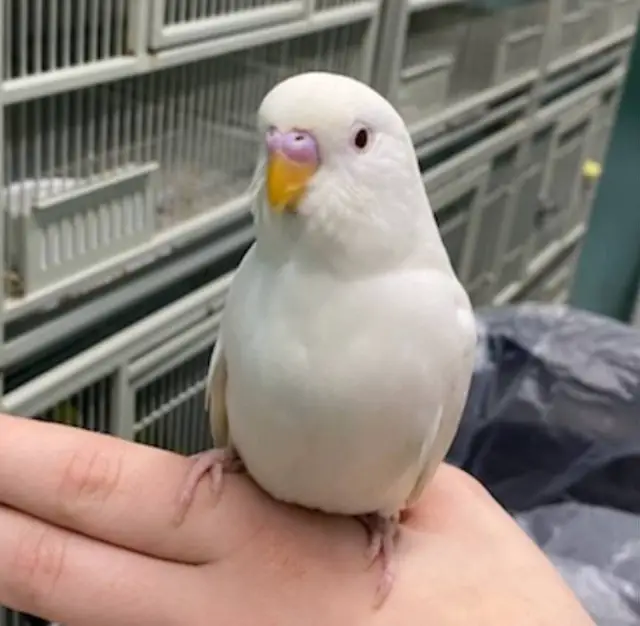
This genetic change leads to a form of albinism, which, in budgies, can manifest as an all-white bird with red or pink eyes.
Yes, that’s right, your white budgie could actually be an albino!
As we discussed earlier, the Ino gene is instrumental in managing the production of melanin, a pigment responsible for the dark colors in a budgie’s plumage, eyes, beak, and feet.
When functioning normally, the Ino gene allows the budgie to produce adequate melanin, giving it its typical coloration.
However, when a mutation occurs in this gene, the production of melanin decreases.
This reduction in melanin results in lighter coloration in the budgie, often leading to the albino phenotype.
In this case, there are no other pigments being produced to give color to the feathers.
As a result, your budgie appears all white.
Coupled with the reduced melanin in the eyes, which causes them to appear red or pink, you have an albino budgie.
It’s important to note that this mutation is sex-linked and recessive, requiring a female budgie to inherit this mutation from both parents to exhibit albinism.
Meanwhile, males can be carriers of the mutation without showing any signs themselves, yet can still pass it on to their offspring.
This intriguing interplay of genetics could be why your budgie is all white.
But what if it’s not an albino? There are other possibilities tied to feather color variations we should explore next.
Dark-Eyed Clear Budgie
If your all-white budgie has dark eyes instead of the pink or red eyes typically associated with albinism, you may have a Dark-Eyed Clear Budgie on your hands.
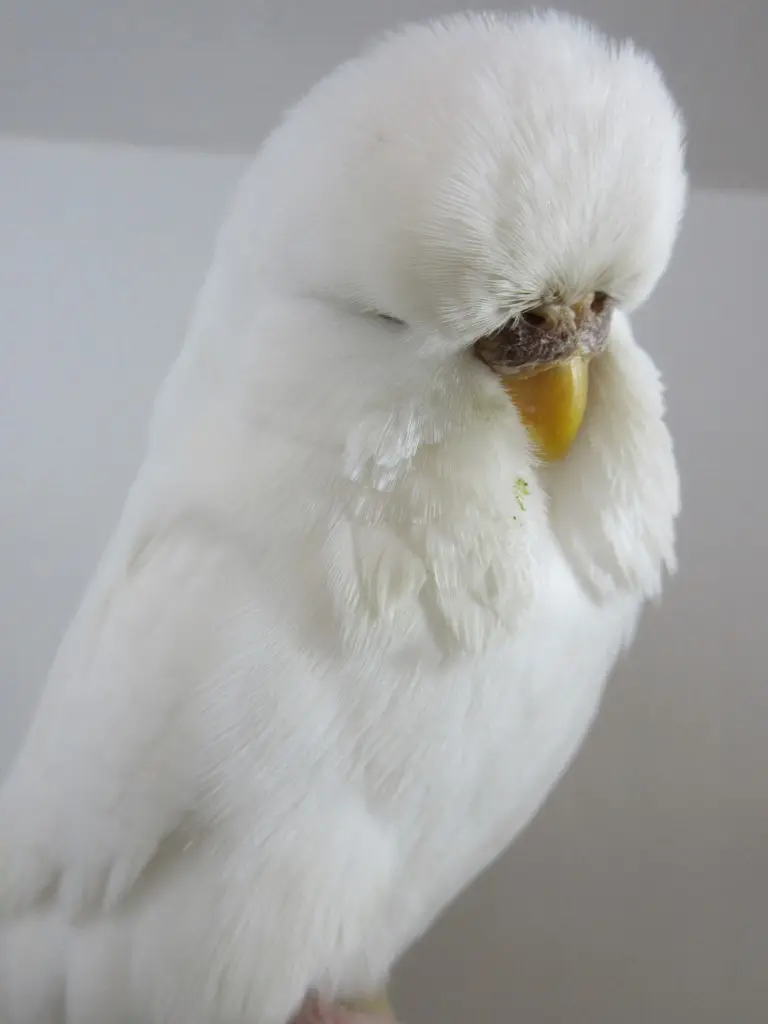
This fascinating genetic combination results in an all-white or all-yellow budgie with dark eyes, as the name suggests.
In the genetics of budgerigars, the Dark-Eyed Clear (often shortened to DEC) is a budgie that results from the combination of two distinct genetic traits: the Clearflight Pied and the Recessive Pied traits.
Let’s break this down.
‘Pied’ refers to having patches of white or yellow feathers breaking up the base color of the bird.
The Clearflight Pied trait usually leads to a budgie with clear, unmarked flights, which are the long feathers on the wings, and often a clear tail.
Conversely, the Recessive Pied trait causes a budgie to have patches of white or yellow throughout the body, interrupting the base color.
When a budgie inherits both these traits, you get a Dark-Eyed Clear Budgie.
In other words, these pied traits act together to ‘override’ the base color, leading to an all-white or all-yellow appearance.
So, if your budgie is all white, lacks any form of marking or color variation on its body, and has dark eyes, it’s highly likely you’re looking at a Dark-Eyed Clear budgie.
The complexity of budgie genetics never ceases to amaze, does it?
This brings us to the second explanation for your all-white budgie.
Still, we have one more variation to explore – the Df Spangle Budgie.
Let’s continue our journey into the captivating world of budgie genetics.
Df Spangle Budgie
Last but not least, your budgie might be all white due to being a Df Spangle Budgie.
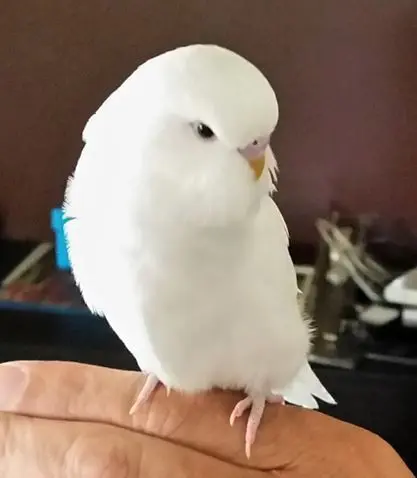
The term “Df” is short for double factor, pointing to a specific trait that a budgie inherits from both its parents.
A Df Spangle Budgie carries two copies of the spangle gene, leading to a unique feather pattern.
The Spangle mutation manifests itself in an interesting way.
It reverses the usual positioning of color on a budgie’s feathers.
Normally, a budgie’s feathers are darker at the base, getting lighter towards the edges.
Spangle budgies, however, have feathers with a light base and a darker ‘spangle’ at the tip.
But how does this result in an all-white budgie? Well, the ‘double factor’ comes into play here.
When a budgie inherits the Spangle mutation from both its parents, the feathers lose their spangles.
Instead, they become a solid light color.
Depending on the budgie’s specific color genetics, this can result in an all-white appearance.
In a Df Spangle Budgie, the body and head generally appear solid white, while the wing patterns may be faintly visible as a slightly different shade of white.
These budgies also have dark eyes, making them similar in appearance to the Dark-Eyed Clear budgie we discussed earlier.
So, if your budgie is uniformly white, with potentially faint wing patterns, and dark eyes, it’s quite possible that you’re a proud owner of a Df Spangle Budgie.
And there you have it, the three main explanations for why your budgie could be all white – the Albino, the Dark-Eyed Clear, and the Df Spangle.
Each possibility showcases the marvel of budgie genetics and the beautiful diversity these delightful birds offer.
| Albino Budgies | Dark-Eyed Clear Budgies | Df Spangle Budgies | |
|---|---|---|---|
| Color | All white | Can be all white | Can be all white |
| Eye Color | Red or pink | Dark | Dark |
| Mutation Involved | Ino gene mutation | Clearbody gene mutation | Double Factor Spangle mutation |
| Unique Features | Lack of melanin leading to white feathers and red or pink eyes | Feathers may appear slightly translucent under certain light conditions | Feather patterns may be faintly visible as a slightly different shade of white |
Faqs
Why Are the Eyes of My All-White Budgie Red or Pink?
The red or pink eye color in an all-white budgie typically signifies the presence of the Albino mutation, caused by a change in the Ino gene.
This mutation decreases the production of melanin, the pigment responsible for dark coloration in birds.
The decrease in melanin gives your budgie’s feathers a white appearance, and it also affects their eye color, making it appear red or pink.
How Can I Tell the Difference Between a Lutino and an Albino Budgie?
The primary difference between a Lutino and an Albino budgie lies in their color and eye color.
A Lutino budgie, while also affected by the Ino gene mutation, exhibits a yellow plumage due to the presence of other pigments that are not affected by the Ino gene mutation.
Meanwhile, an Albino budgie, due to the absence of any other pigments, appears all white.
The Albino budgie also has red or pink eyes, while the Lutino’s eyes remain dark.
Can a Male Budgie Show Albino or Lutino Traits?
Male budgies can carry the Ino gene mutation that leads to Albino or Lutino traits, but they do not show these traits themselves.
This is because the mutation is sex-linked and recessive, meaning a budgie must inherit the mutation from both parents to exhibit the traits.
Males can, however, pass on the mutation to their offspring.
What Is a Spangle Budgie?
A Spangle Budgie is a budgie variant with a unique feather pattern due to a specific gene mutation.
The mutation causes the feathers to have a light base with a darker ‘spangle’ at the tip, inverting the usual color positioning.
If a budgie has two copies of this mutation (making it a Df Spangle Budgie), the feathers become a solid light color, which can result in an all-white or all-yellow appearance.
Are All-White or All-Yellow Budgies Common?
While not as common as the typical green budgie, all-white and all-yellow budgies do occur due to various genetic mutations.
Albino, Lutino, Dark-Eyed Clear, and Df Spangle Budgies are just a few examples of genetic variations that can lead to all-white or all-yellow plumage.
Their occurrence depends on the specific genetic makeup of the parent birds.
What Are Yellow Budgies Called?
Yellow budgies can be divided into various categories based on their genetic mutations.
The most common type of yellow budgie is called a Yellowface, which results from a specific mutation causing the budgie’s face to appear yellow while the body can have a variety of colors.
Lutino budgies, with a yellow base color, are another type, often showcasing entirely yellow feathers with red or pink eyes.
Another type is the Double Factor Spangle Budgie, which is all white, potentially with some faint wing markings, and has dark eyes.
There’s also the Clearflight Pied mutation, which results in a budgie with a predominantly yellow body and clear, unmarked flight feathers.
What Are White Budgies Called?
White budgies can be classified into different categories based on their genetic mutations.
The Albino budgie, for instance, is entirely white with red or pink eyes and is the result of the Ino gene mutation.
Another type is the Double Factor Spangle Budgie, which is all white, potentially with some faint wing markings, and has dark eyes.
This results from the Spangle mutation when inherited from both parents.
Similarly, the Dark-Eyed Clear budgie, which results from a combination of the Clearflight Pied trait and the Recessive Pied trait, appears as an all-white budgie with dark eyes.
